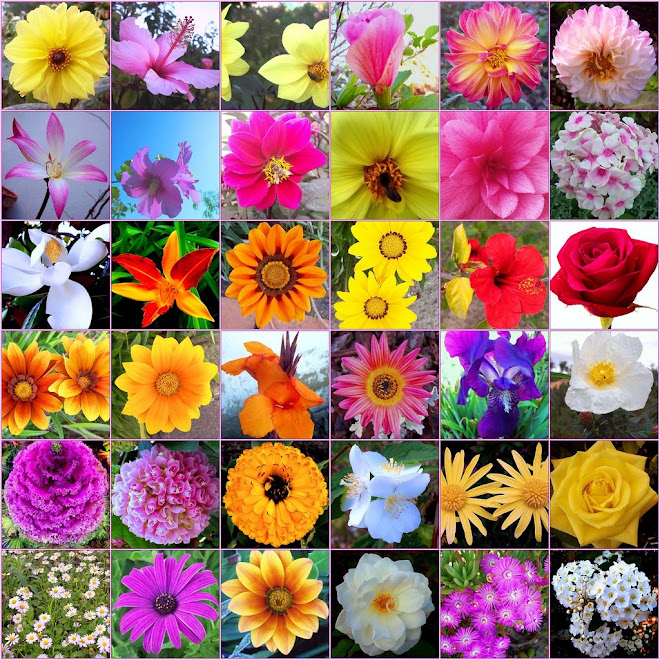
Although it is true that long, thin hummingbird bills are nicely adapted to take nectar from long, tubular flowers, it's a misconception that Ruby-throated Hummingbirds only feed from blossoms that match their bill size and shape. The orange flowers of Trumpet Creeper (right) are indeed "hummingbird magnets," but hummers at Hilton Pond Center are curious beasts; they flit around sticking their bills--and tongues--into all sorts of objects to see if something sweet is hidden within. We've seen young ruby-throats persistently probe everything from bright satin ribbons to roadside stop signs, but they eventually move on to legitimate food sources when they comprehend there are no nutrients to be had. On the other hand, when those fledgling hummers sample Rose of Sharon, they immediately realize its non-tubular four-inch cup-shaped flower may have nearly as much tasty nectar as Trumpet Creeper.
If you're a native plant purist, you may scoff at folks who use Rose of Sharon to attract hummingbirds, but it's actually a nice asset to a backyard habitat. The 10-foot-tall shrub is not actually a rose but is in the Mallow Family (Malvaceae) and is sometimes called "Shrub Althea." Its scientific name--Hibiscus syriacus--implies it comes from the Middle East, but its origins are India and East Asia. In fact, Rose of Sharon is the national flower of Korea. Biblical scholars originally supposed this large, showy blossom was mentioned in the Song of Solomon, but biogeographers now think Solomon's plant was a Rockrose that grows commonly in the Mideast. Such was also the conclusi
drawn by Carolus Linnaeus, who originally classified H. syriacus in the 18th century based on a herbarium specimen from Syria (left)--to which the species apparently had been imported long ago. These days, Rose of Sharon is grown nearly worldwide as an ornamental, but in the U.S. it seems to do best east of the Great Plains. Since it can escape from cultivation, Rose of Sharon may become a "weed"--i.e., grow where it's not wanted; in most cases it is easily controlled and seldom becomes truly invasive. We didn't plant Rose of Sharon at Hilton Pond Center, but several specimens persist with our blessings after more than two decades--even thriving in the middle of the Trumpet Creeper patch outside the old farmhouse window. This helps out the viney Trumpet Creeper, which uses shrubby Rose of Sharon for support, and both these nectar-rich plants help out our hummingbirds.
Rose of Sharon comes in many colors--especially white, lilac, and pink; it occurs as a single flower (all shown here), or as a hybridized double. Blooms first occur in late spring and continue through early fall, making Rose of Sharon one of the few summer-blooming shrubs. Individual blossoms open in early morning, close at night, and usually last less than three days. Regardless of the flower's color, there is almost always an intensely maroon central spot formed by a concentration of pigment at the bases of five large petals. This target zone (below)--which is also where nectar pools--attracts the attention of hungry hummingbirds and may serve as a "bee guide" for insect pollinators.
The reproductive part of the flower is a long finger-like stalk typical of hibiscus and other mallows (top photo); it consists of many pollen-bearing stamens and a large pistil head at the tip. Once fertilized, each flower makes a large woody seed pod or capsule that is almost acorn-shaped.
The pod has five cells, each containing three or more seeds that are brownish-red quarter-inch disks. Pods persist through the winter (and sometimes longer), dispersing all their seeds by the spring season. Pruning a Rose of Sharon in autumn before seed capsules open is an effective way to minimize any invasive qualities the shrub may have. On the other hand, ripened seeds are very easy to collect by shaking the pods into a cloth bag--just in case you want to propagate some more H. syriacus
The almost-triangular serrated leaf of Rose of Sharon is semi-glossy dark green and about 3" long; the foliage is also deciduous, which causes much consternation among forgetful gardeners. After the leaves drop in autumn, Rose of Sharon goes into a very long resting period and is one of the last shrubs to green up in spring. We often get inquiries from folks who think their prized Rose of Sharon collection froze to death during the winter, when all the gardeners needed was a little more patience and a reminder that these shrubs are invariably "late-leafers."
-hiltonpond.org








waooo nice post about "Rose of Sharon"
ReplyDeleteThanks,
Crude Oil Tips Free Trial